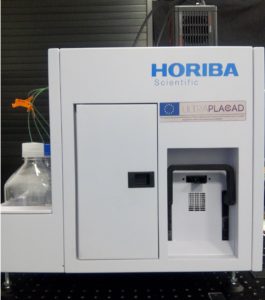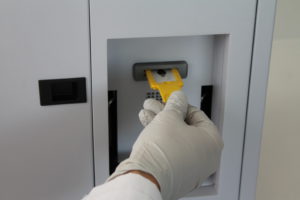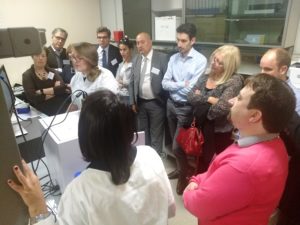Elena Turco
ULTRAPLACAD project successfully finished!
The ULTRAPLACAD project, funded with 6 million euro by the European Commission under Horizon 2020, has been completed after 42 months of research. The project led to the development of a new device for the diagnosis of colorectal cancer, which allows early diagnosis through a simple blood sample. The device was tested at the Regina Elena National Cancer Institute in Rome. The new system enables the simultaneous detection of DNA alterations and the presence of specific proteins in the blood, which represent a potential warning sign for colorectal cancer. A major advantage is that the system can selectively recognize tumour-associated molecules, such as DNA and proteins, using nanotechnology, with no need for amplification of samples. The new technology – although developed specifically for the early detection of colorectal cancer – could also be used for the screening of other types of cancer diseases, with considerable benefits in terms of diagnosis and costs for the national health systems.
ULTRAPLACAD Newsletter number 3 is out!
The ULTRAPLACAD_Newsletter nº3_V05 contains the description of the ULTRAPLACAD industrial prototype and of the methods developed in the project for the chip mass production (the link to the Youtube video is also reported). ULTRAPLACAD partners describes in the Newsletter the achievements obtained for the microRNA detection, the DNA recognition and the surface functionalization.
The ULTRAPLACAD Newsletters aim at maintaining the visibility of the project, create awareness and expectations regarding the final results and inform the target audience about advances made in the project. Please, follow us at www.ultraplacad.eu!
ULTRAPLACAD industrial prototype for early cancer diagnosis
 The ULTRAPLACAD prototype integrating the novel surface plasmon resonance imaging (NESPRI) and plasmon-enhanced fluorescence (PEFSI) sensing technologies has been assembled. Functional tests are in progress. In parallel, the integrated cartridges for in-vitro cancer detection are under development using high volume manufacturing methods.
The ULTRAPLACAD prototype integrating the novel surface plasmon resonance imaging (NESPRI) and plasmon-enhanced fluorescence (PEFSI) sensing technologies has been assembled. Functional tests are in progress. In parallel, the integrated cartridges for in-vitro cancer detection are under development using high volume manufacturing methods. 
In ULTRAPLACAD many markers can be measured simultaneously. ULTRAPLACAD diagnostic platform will improve early diagnostic testing and will enable more specific selection of patients for therapy, as well as therapy monitoring from liquid biopsies, thus reducing invasive procedures and improving patient management.
During the next year, the ULTRAPLACAD platform including the assays for the detection of mutated DNAs, microRNAs and tumor autoantibodies (a-TAAs) will be finalized and validated. Please, stay updated about the upcoming project results (www.ultraplacad.eu).
ULTRAPLACAD video on R2R mass manufacturing
The integrated microfluidics for the ULTRAPLACAD plasmonic cartridge is manufactured with a Roll-to Roll (R2R) process at VTT. In the video you’ll see the different steps for mass-production: laser processing, lamination, dispersion of biomolecules and final assembly. This Roll-to-Roll manufacturing process will allow to develop in ULTRAPLACAD a plasmonic device for early, ultrasensitive detection of cancer. Enjoy the video on YouTube!
ULTRAPLACAD article and interview published on GenomeWeb website
The project coordinator Giuseppe Spoto (INBB) and project manager Elena Turco (AMIRES) had the opportunity to present ULTRAPLACAD project to the editor of GenomeWeb, an independent online news organization based in New York and focused on the latest advancements in molecular biology research and molecular diagnostics. The article, entitled “European Consortium Developing Bimodal Liquid Biopsy Test for Colorectal Cancer”, was published on 20th March 2017. During the interview with the journalist Giuseppe Spoto described the project objectives, its innovative technological aspects, the Consortium of partners, their roles and the first achieved results. Elena Turco highlighted the socio-economic impact that ULTRAPLACAD will have on European citizens and presented the preliminary plan for the validation of the final solution and its introduction into the market. For more information you can read the whole article here.
ULTRAPLACAD Newsletter number 2
The ULTRAPLACAD Newsletter number 2 is ready! It includes an overview of the project after the first 18 months, the most updated results, the work done by IPE in the development of optical biosensors and by SCRIBA in the development of the microfluidic device.
The Newsletters and their regular dissemination will help to maintain the visibility of the project during its whole duration (42 months), create awareness and expectations regarding the final results and inform the target audience about advances made in the project.
ULTRAPLACAD project is halfway
After the submission to the European Commission of the reports describing the activities performed by the partners during the first 18 months, the project ULTRAPLACAD is halfway, with important results already achieved.
The project started with the identification of technical specifications of ULTRAPLACAD final industrial prototype. ULTRAPLACAD is focused at developing a plasmonic-based device with integrated nanostructures for the detection of mutated DNAs, microRNAs and tumor autoantibodies (a-TAAs). The detection of all these molecular cancer biomarkers freely circulating in blood of colorectal cancer patients will be combined in a single device that is expected to overcome hurdles and limitations of the currently available approaches.
In the first 18 months, nanostructure geometries for the novel surface plasmon resonance imaging (NESPRI) and plasmon-enhanced fluorescence (PEFSI) sensing technologies were identified. Probes for the selected all-RAS mutations and microRNAs have been synthesized and candidate antigenic peptides for a-TAA detection have been defined. ULTRAPLACAD will detect genomic DNA and microRNA with no need for preliminary amplification of the nucleic acid sequences. In addition, a-TAAs will be detected with an improved sensitivity with respect to conventional fluorescence detection platforms. Attomolar detection of all-RAS mutations and femtomolar detection of microRNAs have been already demonstrated. ULTRAPLACAD will develop a bimodal industrial prototype and the first version of NESPRI and PEFSI reader laboratory prototypes have been completed. Automated fabrication processes suitable for low cost mass production will be developed in the project and high-volume fabrication of nanostructured disposable chips has been already demonstrated.
ULTRAPLACAD project has a duration of 42 months, please, stay updated about the upcoming project results!
EC Research and Innovation Newsletter: ULTRAPLACAD as success story!
The article entitled “A compact device to detect the early signs of cancer” is published on 16th September 2016 in the section “Success stories” of the “What’s new on the EC’s Research & Innovation web site” Newsletter (week 38, 2016). Please, download here the PDF version.
Congratulation to ULTRAPLACAD project, success story in the field of early minimal-invasive cancer detection!
1st official ULTRAPLACAD Newsletter and brochure
ULTRAPLACAD first results published!
Two peer reviewed papers from ULTRAPLACAD project were published in April-May in two international Journals: Elsevier, Talanta, The International Journal of Pure (DOI: 10.1016/j.talanta.2016.05.023) and Applied Analytical Chemistry and Spandidos Publications, International Journal of Oncology (DOI: 10.3892/ijo.2016.3503).
The ULTRAPLACAD peer-reviewed articles are published in OPEN ACCESS repositories. The project website is also used as open access repository and the papers are available in .pdf format under the webpage “Results/Scientific publications”. Enjoy reading!
Congratulations to all the authors!



